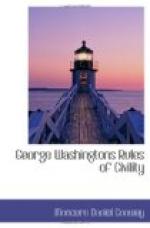It would appear that the purpose of this emigration was to minister to a settlement of French Huguenots at Monacan (or Manakintown, as it was called) on James River. The first band of these refugees had gone over in 1690, under the leadership of Olivier de la Muce, and 600 others had followed in 1699, with their clergyman, Phillipe de Richebourg. The Assembly of Virginia gave them a large tract of land in Henrico County—not far from where Richmond now stands—exempting them from taxation. The name of James Marye first appears in Virginia (1730) as christening a child in King William Parish, as it was called,—after the King who had favoured this Huguenot colony.
In 1727 the town of Fredericksburg was founded. In I732 Col. Byrd visited the place, and wrote: “Besides Col. Willis, who is the top man of the place, there are only one merchant, a tailor, a smith, an ordinary keeper, and a lady who acts both as a doctress and coffeewoman.” This “Col. Willis” had married Washington’s aunt (and godmother), and there were other families of the neighbourhood connected with the Washingtons. It was not until 1739 that Captain Augustine Washington (the General’s father) went to reside near Fredericksburg. Soon after the birth of George (Feb. 11, 1731 Old Style) the family left their homestead in Westmoreland county, Virginia, and resided on their farm, now known as “Mount Vernon.” (It was so named by Washington’s elder half-brother, Lawrence, who built the mansion, in 1743-5, in honour of the English Admiral Vernon, with whom he served as an officer at Carthagena.) Although he nowhere alludes to the fact, George Washington’s earliest memories, as I have elsewhere shown[1], were associated with the estate on which he lavished so much devotion, and which the Ladies’ Mount Vernon Association has made his most characteristic monument. The Rev. Jonathan Boucher, teacher of Mrs. George Washington’s son John Custis, says that Washington was “taught by a convict servant whom his father had bought for a schoolmaster.” This was probably one of a shipload of convicts brought by Captain Augustine Washington from England in 1737. When the family removed to the neighbourhood of Fredericksburg (from which, however, they were separated by the Rappahannock river), the children went to school (probably) at Falmouth,—a village fifty years older than Fredericksburg, and about two miles above, on the opposite side of the river. A church had been erected in Falmouth (Brunswick parish), but that in Fredericksburg was not completed until some years later. After the death of his father (April 12, 1743) George was sent to reside with his half-brother Augustine, at “Wakefield,” the old homestead in Westmoreland where he was born. He returned to live with his mother near Fredericksburg, in 1715. That he then went to school in Fredericksburg appears by a manuscript left by Col. Byrd Willis, grandson of Col. Harry Willis, founder of the town, in which he states that his father, Lewis Willis was Washington’s schoolmate. The teachers name is not given, but there can be little doubt that it was James Marye.




